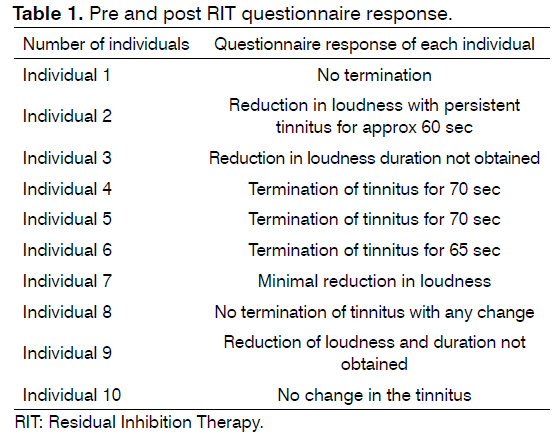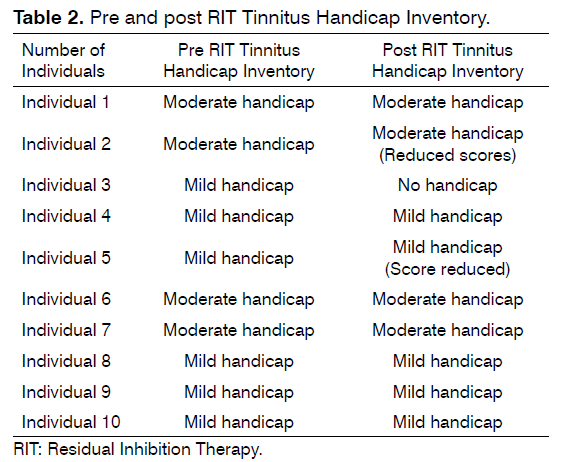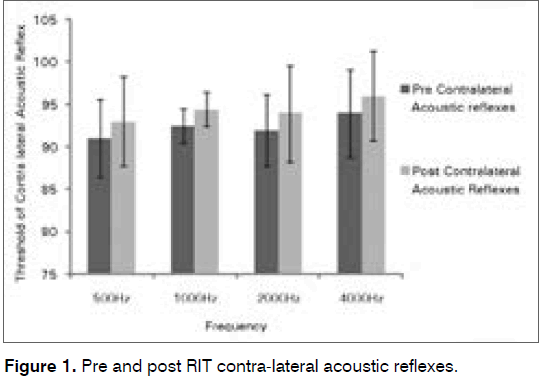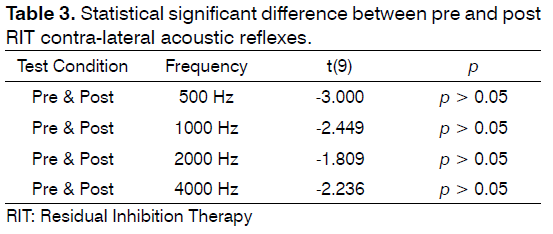The International Tinnitus Journal
Official Journal of the Neurootological and Equilibriometric Society
Official Journal of the Brazil Federal District Otorhinolaryngologist Society
ISSN: 0946-5448

Google scholar citation report
Citations : 12717
The International Tinnitus Journal received 12717 citations as per google scholar report
The International Tinnitus Journal peer review process verified at publons
Indexed In
- Excerpta Medica
- Scimago
- SCOPUS
- Publons
- EMBASE
- Google Scholar
- Euro Pub
- CAS Source Index (CASSI)
- Index Medicus
- Medline
- PubMed
- UGC
- EBSCO
Volume 19, Issue 1 / June 2014
Research Article Pages:63-67
Effectiveness of residual inhibition therapy
Authors: Teja Deepak Dessai; Rugma Gopinath; Lavanya Krishnan; Greeshma Susan
PDF
Abstract
Introduction: Tinnitus is considered as one of the major symptom associated with many pathologies along with its presence in individuals with normal hearing. With varied cause and mechanism of its generation and increase in number of individuals with complaint of tinnitus, rehabilitation becomes crucial for Audiologists.
Objective: Study was undertaken to find the efficacy of Residual Inhibition Therapy as treatment procedure for unilateral tinnitus in individuals with normal hearing by comparing pre and post Residual Inhibition Therapy, Contra-lateral Acoustic Reflexes and Tinnitus Handicap Inventory.
Materials and Methods: Ten subjects between the age range of 20-45 years were included for the study. Tinnitus pitch and intensity were matched and Residual Inhibition Therapy was provided. The Pre Residual Inhibition Therapy, contra-lateral acoustic reflexes and Tinnitus Handicap Inventory scores were compared to post Residual Inhibition Therapy, contra-lateral acoustic reflexes and Tinnitus Handicap Inventory scores.
Results and Conclusion: Statistical analysis revealed no significant difference, however, elevated contra-lateral acoustics reflexes post Residual Inhibition Therapy were seen. Even though small sample size made it hard to conclude on the effectiveness of Residual Inhibition Therapy as treatment of tinnitus, elevated contralateral acoustic reflexes post Residual Inhibition Therapy pay way for further advanced studies on the same.
Keywords: acoustic impedance tests, questionnaires, tinnitus.
Introduction
Tinnitus is referred to, a sound generated by brain in the absence of acoustic stimulation due to increased neural activity [1]. It is considered to be an auditory phantom sensation experienced by 10-15 persons out of general population [2]. The mechanism and nature of tinnitus generation is a major topic of research. However, few postulated etiologies can be attributed to age, exposure to loud noise, earwax blockage, air bone changes, Ménière’s disease, tempro-mandibular joint disorders, head or neck injuries, acoustic neuroma, etc. In contrast to the reasons behind tinnitus [3] quoted normal hearing individuals with presence of tinnitus. As opposed to the traditional paradigm-tinnitus as an ear disease, today, tinnitus is accepted as a brain disorder [4]. Tinnitus can be rated as mild to catastrophic level thereby having severe effects on social and emotional status, poor job performances, relationships and social functioning [5].
Today, with advancing field of Audiology, treatment strategies are aimed to reduce or eliminate symptoms and distress caused by tinnitus which includes Residual Inhibition Therapy (RIT), Masking Tinnitus Retraining Therapy and Cognitive Behavioral Therapy. RIT is referred to the auditory stimulation that results in temporary suppression of tinnitus [6]. Use of this treatment has shown 90% of the subjects with tinnitus relief and 10% with modification in tinnitus with minimal reliefs [7]. Literature has also reported the experience of residual inhibition in more than 8 out of 10 persons with tinnitus [8] and reduction in tinnitus loudness by 39% [9]. Use of RIT by Rex & Maha [10] has showed 16% effectiveness in reducing the tinnitus. This suppression of tinnitus provides brief relief which lets victims to exert some control over the trouble. Possible reasons for tinnitus suppression are stated as temporary desensitization by brain on exposure to tinnitus matched frequency noise [11] and influence of overlapping central mechanism [12]. Thus, the purpose of this study was to gain information on the effectiveness of Residual Inhibition Therapy as a treatment of tinnitus in normal hearing subjects experiencing tinnitus unilaterally and hence the study was undertaken.
In support of the literature, audiological practice encounters an increasing number of tinnitus and thus, one needs to evaluate the efficacy of the treatment. Thus, the study was designed to know the effectiveness of RIT by comparing pre RIT contra-lateral acoustic reflexes to post RIT contra-lateral acoustic reflexes in normal hearing subjects experiencing continuous tinnitus unilaterally.
Methods
Participants
The study was undertaken in a multidisciplinary teaching hospital. The study protocol was approved by the Institutional Ethical Committee Board at Nitte Institute of Speech and Hearing, Mangalore. Written consent was taken from each subject recruited for the study. Total ten subjects with a complaint of tinnitus persisting for more than two weeks were recruited. Subjects selected were within the age range of 20-45years. Inclusion criteria, called for subjects with normal hearing. Subjects with presence of any middle ear infection and/or any neurological symptoms, vertigo, giddiness were excluded from the study inclusion criteria.
Procedure
The study followed pre-post experimental design. Subjects answered a questionnaire developed by five experienced Audiologists to rule out nature of complaint. Questions in the questionnaire probed to know the onset (sudden or gradual), progression (static or progressive), nature of the tinnitus (intermittent, continuous), ear experiencing tinnitus (right, left or both ears) and duration of tinnitus persistence. Similarly, Tinnitus Handicap Inventory [13] was administered on each subject. This inventory consists of 25 questions with a 4-point rating scale. Subjects with mild to moderate severity (score ranging from 18 to 56) were considered for the study. This inventory helped to rate the severity of tinnitus and to know its severity on day today life. Subjects experiencing continuous tinnitus with static nature for two weeks unilaterally were shortlisted.
Shortlisted subjects further underwent the following testing. Firstly, diagnostic GSI 61 Clinical Audiometer was used to estimate pure-tone thresholds. Thresholds of each subject were found out using both air conduction and bone conduction mode. Modified Hughson and Westlake procedure [14] was used to mark the thresholds of subjects. In air conduction testing, frequencies 250 Hz, 500 Hz, 1000 Hz, 2000 Hz, 4000 Hz and 8000 Hz were checked. However, in bone conduction testing, frequencies 250 Hz, 500 Hz, 1000 Hz, 2000 Hz, and 4000 Hz were checked. Recruitment of the subject for further testing asked for threshold ranging from -10 to 25dBHL. Secondly, Immittance Audiometry (Tympanometry and Reflexometry) using calibrated Interacoustic AT (235) Immittance Audiometer with probe tone of 226 Hz was used to know the integrity of tympanic membrane and middle ear status. Type ‘A’ tympanogram with present ipsi-lateral and contra-lateral acoustic reflexes were considered. Thirdly, Distortion Product Oto-acoustic Emission (DPOAE) was carried out using GSI Audera to rule out normal outer hair cell functioning. Ten subjects underwent RIT [15] as remedial option. Subjects with presence of any middle ear infection and/or any neurological symptoms, vertigo, giddiness were excluded from the study inclusion criteria.
Reflexometry at 500 Hz, 1000 Hz, 2000 Hz and 4000 Hz was repeated to elicit the baseline contra-lateral acoustic reflexes pre Residual Inhibition Therapy. With the baseline contra-lateral acoustic reflex, first sitting of therapy was initiated. First step included matching the pitch, loudness and nature of tinnitus. This provided frequency, intensity and nature of tinnitus for the baseline of RIT. On obtaining baseline, frequency specific narrowband noise was delivered to the ear experiencing tinnitus for duration of 60 sec. Presentation level was maintained as 10 dBSL of the tinnitus threshold. Post first sitting with a time gap of 1-2 minutes, contra-lateral acoustic reflexes were retested. The obtained pre contralateral acoustic reflexes and post contra-lateral acoustic reflexes were compared to each other to get the effect of RIT on contra-lateral acoustic reflexes.
Statistical Analysis
Statistical analysis using paired sample t test is carried out with Bonferroni’s correction applied for multiple comparison between pre and post comparison of four frequency thresholds in contra-lateral reflexometry.
Results
The present study investigated the effectiveness of RIT using a questionnaire aiming to betterment of tinnitus and contra-lateral acoustic reflexes in adult individuals. For this, obtained questionnaire score and contra-lateral acoustic reflexes were measured at octave frequencies between 500 Hz and 4000 Hz were compared. The comparison was done at two circumstances: pre RIT experience and post RIT experience. Residual inhibition lasted for approximately 70 sec post RIT. The obtained results are quoted below:
From Table 1 we can understand that, not all the individuals benefited with the RIT. Of the ten individual only seven individuals showed betterment. Four individuals reported of reduction in tinnitus loudness, 3 reported of complete termination of tinnitus and 3 reported of no change in the tinnitus.
From Table 2, the Tinnitus Handicap Inventory did not show any significant changes in the scores obtained pre and post RIT. Three individuals showed betterment from tinnitus. However, the scores did not vary significantly.
Similarly, obtained contra-lateral reflexes pre and post RIT were compared using sample t-test. Bonferroni’s correction was applied for multiple comparison between pre and post comparison of four frequency thresholds.
From Figure 1 we can conclude that, post RIT contra-lateral acoustic reflexes required higher intensity in comparison to pre RIT contra-lateral acoustic reflexes to elicit a reflex. However there is no significant difference between the pre and post RIT contra- lateral acoustic reflexes.
From Table 3 it is evident that there is no significant difference (p > 0.05) between contra-lateral acoustic reflexes pre and post RIT (Boneferroni’s correction applied for multiple comparisons). Post contra-lateral acoustic reflexes required higher intensities to elicit a reflex.
Discussion
Primary aim of the study was to establish the effectiveness of RIT on subjects experiencing tinnitus. For this, pre and post RIT questionnaire response and contra-lateral acoustic reflexes were compared. This comparison did not yield a significant difference. The insignificant result to the success of RIT can be attributed to the influence of identification level of tinnitus expertise, the inability to match the tinnitus exactly due to overlapping of tinnitus frequency in some subjects and the effect of RIT lasting for few seconds or minutes8. Studies have reported that presence of any phobia related to tinnitus or any negative thought about tinnitus will lead to slow desensitization of tinnitus. This explains the part of neuro-physiological model, where annoyance or displeasure although not strongly evoked stimulate limbic and autonomic systems producing intrusive and aversive emotions and reducing the quality of life. The created negative feelings to a person cannot be treated purely by only audiological help. Thus, leading to failure of RIT when used as a standalone tool [16].
The depth and duration of residual inhibition was found to be varied from individual to individual and the peak measurement of duration of residual inhibition was 70 sec. This variation may be due to quieter level of stimulus intensity and lesser duration of narrow band noise played to the subjects which were required to influence the tinnitus triggering system. The influence of masking level that deepens the residual inhibition as it goes above the level required to mask tinnitus [17] or due to the impedance offered by the cochlear dead region even in normal hearing individuals with tinnitus [18] could have yield poorer results.
The current study results are in support with the previous literature where the 57% of tinnitus experiencing subjects relapse in 2 minutes, 23% subjects in 2 to 4 minutes, 11% subjects in 4 to 6 minutes, 4% subjects in 6 to 8 minutes, 2% subjects in 8 to 10 minutes and 3% subjects with more than 10 minutes [19]. Explanation on subject’s response to RIT after the target sound ends is with the start of silent phase of 20 to 35 seconds, followed by 30 to 35 seconds in which the tinnitus sound gradually recovers back. Similarly, the literature reports that few subjects experience increase in the tinnitus loudness than the decrement which lasts for a duration less than one minute [20]. However, only 54% subjects experienced complete silence in total 46 subjects with tinnitus and who underwent. Follow-up report of three subjects in the literature study has shown no change in tinnitus even after exposure to target stimulus for a run of 2 to 3 weeks RIT [15].
The current study used duration of 60 seconds for the presentation of target stimulus and the RIT success rate is obtained with increase in number of the target stimulus experienced to suppress tinnitus however, due to the fatigue of masking in subjects some might require longer duration of target stimulus to maintain residual inhibition [12]. RIT has approved good effectiveness when the pitch of the tinnitus is matched with the target sound presented to suppress tinnitus [15] however; in the present study we used narrowband noise of the nearing experienced tinnitus frequency. Residual inhibition will be effective with longer exposure to target stimulus and subjects who experience no residual inhibition in the initial stages may experience it after regular exposure to target sound [21]. In the present study the effect of RIT was evaluated in a short time post RIT.
The poor agreement with the earlier literature could be due to differences in noise bandwidths used for the study, tinnitus pitch tuning methods, sound levels used and the various differences in the experimental details. Also, sample size used is small which can significantly influence the effectiveness of RIT.
Summary and Conclusion
The present study aimed at testing the effectiveness of RIT using pre and post tinnitus questionnaire response and contra-lateral acoustic reflexes. Contra- -lateral acoustics reflex thresholds obtained post therapy state is relatively higher than the pre therapy state, however, Tinnitus Handicap Inventory scores showed not much improvement. Hence, RIT as a standalone tool to suppress the tinnitus is questionable. However, further is warranted as the sample size used in current is small.
References
- Sweetow RW, Sabes JH. Effects of acoustical stimuli delivered through hearing aids on tinnitus. J Am AcadAudiol. 2010;21(7): 461-73. DOI:http://dx.doi.org/10.3766/jaaa.21.7.5
- Henry JA, Dennis KC, Schechter MA. General review of tinnitus: prevalence, mechanisms, effects, and management. J Speech Lang Hear Res. 2005;48(5):1204-35. DOI: http://dx.doi.org/10.1044/1092- 4388(2005/084)
- Sanchez TG, Medeiros IR, Levy CP, RamalhoJda R, Bento RF. Tinnitus in normally hearing patients: clinical aspects and repercussions. Braz J Otorhinolaryngol. 2005;71(4):427-31. PMID: 16446955
- Roberts LE, Eggermont JJ, Caspary DM, Shore SE, Melcher JR, Kaltenbach JA. Ringing ears: the neuroscience of tinnitus. J Neurosci. 2010;30(45):14972-9. DOI: http://dx.doi.org/10.1523/ JNEUROSCI.4028-10.2010
- Henry JA, Schechter MA, Nagler SM, Fausti SA. Comparison of tinnitus masking and tinnitus retraining therapy. J Am AcadAudiol. 2002;13(10):559-81.
- Vernon JA, Meikle MB. Measurement of tinnitus: An update. In: Kitahara M, ed. Tinnitus: Pathophysiology, Diagnosis and Treatment. Tokyo: Igaku-Shoin; 1988. p.36-52.
- Vernon JA, Meikle MB. Tinnitus masking. In: Tyler R, ed. Tinnitus Handbook. San Diego: Singular, Thomson Learning; 2000. p.313-56.
- Witchard C. Residual Inhibition. Hush tinnitus. 2013. Version 1.1 [Cited 2015 Jul 13]. Available from: http://www.residualinhibition. com/residual-inhibition.pdf
- Reavis KM, Rothholtz VS, Tang Q, Carroll JA, Djalilian H, Zeng FG. Temporary suppression of tinnitus by modulated sounds. J Assoc Res Otolaryngol. 2012;13(4):561-71. DOI: http://dx.doi.org/10.1007/ s10162-012-0331-6
- The Canadian Hearing Society, Toronto, Ontario, Canada Rex Banks M.A., CCC-A Reg. CASLPO, MahaAtrach, M.Cl. Sc. Reg. CASLPO.Effectiveness of Residual Inhibition Therapy (RIT). An Ontario Trillium Project [Cited 2015 Jul 13]. Available from: http:// www.experthearingsolutions.com/PDFs/RIT.pdf
- De Ridder D, De Mulder G, Walsh V, Muggleton N, Sunaert S, Møller Magnetic and electrical stimulation of the auditory cortex for intractable tinnitus. Case report.J Neurosurg. 2004;100(3):560-4. DOI: http://dx.doi.org/10.3171/jns.2004.100.3.0560
- Feldmann H. Homolateral and contralateral masking of tinnitus bynoise-bands and by pure tones. Audiology. 1971;10(3):138-44. DOI:http://dx.doi.org/10.3109/00206097109072551
- Newman CW, Jacobson GP, Spitzer JB. Development of the Tinnitus Handicap Inventory. Arch Otolaryngol Head Neck Surg. 1996;122(2):143-8. PMID: 8630207 DOI:http://dx.doi.org/10.1001/archotol.1996.01890140029007
- Carhart R, Jerger JF. Preferred methods for clinical determination of pure-tone thresholds. J Speech Hear Dis. 1959;24(4):330-45. OI:http://dx.doi.org/10.1044/jshd.2404.330
- Roberts LE, Moffat G, Baumann M, Ward LM, Bosnyak DJ. Residual inhibition functions overlap tinnitus spectra and the region of auditory threshold shift. J Assoc Res Otolaryngol. 2008;9(4):417-35. DOI: http://dx.doi.org/10.1007/s10162-008-0136-9
- Hazell JWP. Support for a neurophysiological model of tinnitus:research data and clinical experience. Proceedings of the Vth International Tinnitus Seminar; 1995 July 12-15, Portland, Oregon, USA.
- Tyler RS, Conrad-Armes D, Smith PA. Postmasking effects of sensorineural tinnitus: a preliminary investigation. J Speech Hear Res. 1984;27(3):466-74. DOI: http://dx.doi.org/10.1044/ jshr.2703.466
- Weisz N, Müller S, Schlee W, Dohrmann K, Hartmann T, Elbert T. The neural code of auditory phantom perception. J Neurosci. 2007;27(6):1479-84. DOI: http://dx.doi.org/10.1523/JNEUROSCI. 3711-06.2007
- Meikle MB, Creedon TA, Griest SE. Tinnitus Archive, second edition. Oregon: Oregon Hearing Research Center, Department of Otolaryngology, Oregon Health & Science. University; 2004.
- Vernon JA. Some observations on residual inhibition. In: Paparella MM, Meyerhoff WL, eds. Sensorineural Hearing loss, vertigo and tinnitus. Ear Clinics International. Baltimore: Williams & Wilkins; 1981.p.138-44.
- Robert ES, Robert JO. Evaluation and Selection of Maskers and Other Devices Used in the Treatment of Tinnitus and Hyperacusis. Trends Amplif. 1999: 4(1): 6-26. doi: 10.1177/108471389900400102
References
1Lectutrer, Nitte Institute of Speech and Hearing, Mangalore University, Approved by Rehabilitation Council of India. E-mail: dessaiteja@gmail.com
2Intern (BASLP), Nitte Institute of Speech and Hearing, Mangalore University, Approved by Rehabilitation Council of India. E-mail: chatvdruk@gmail.com/lavanya.krish1610@gmail.com/steevjohnshaju@gmail.com
Institution: Nitte Institute of Speech and Hearing, K. S. Hegde Medical Academy, Derelakatte Mangalore Dakshina Kannada - India.
Send correspondence to:
Teja Deepak Dessai
Lecturer, Department of Audiology and Speech Language Pathology
Nitte Institute of Speech and Hearing, Mangalore, Dakshina Kannada - India
Paper submitted to the ITJ-SGP (Publishing Management System) on May 21, 2015; and accepted on June 23, 2015. cod. 197
Citation: Dessai TD, Gopinath R, Krishnan L, Susan G. Effectiveness of residual inhibition therapy. Int Tinnitus J. 2014;19(1):63-67






